Strokes to the portrait of Admiral Rozhestvensky
Some contemporaries represented him as a victim of circumstances that fell under the Moloch of the archaic system of empire management. Soviet historians and writers described him as a despot and a petty tyrant, who, having almost dictatorial powers, was to have sole responsibility for the defeat of the Russian squadron in Tsushima. In our time, a number of “researchers” develop various conspiracy theories, making the admiral an agent of the Bolsheviks, then a minion of freemasons.
The purpose of this article is not a complete and comprehensive description of the life of this historical character, only the placement of some accents, let's say, the addition of a few strokes to the portrait written earlier.
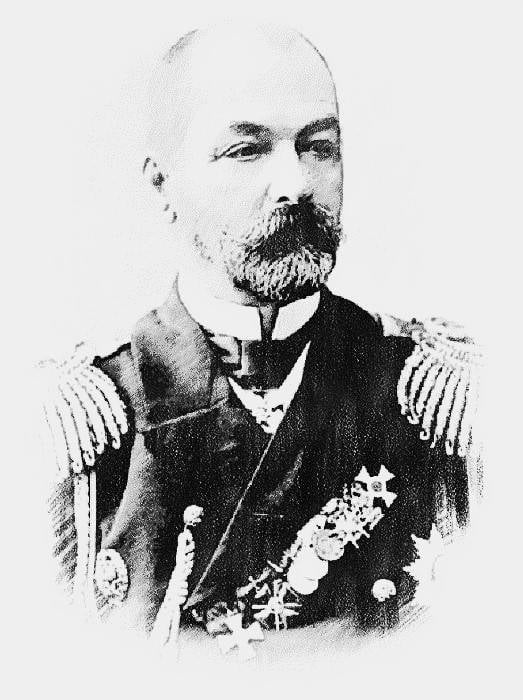
Figure 1. Vice Admiral Z.P.Rozhensky
I. Sources
Arguing about a man who died more than a hundred years ago, it is impossible not to touch on the topic of the sources on which these arguments are based.
History has preserved for us several important types of documents:
1. Orders and official correspondence of the admiral.
2. Admiral's private correspondence, letters from other participants in the campaign of the Second Pacific Squadron.
3. The testimony given by Z.P. Rozhestvensky and other officers during the investigation into the causes of the Tsushima disaster.
4. The memoirs left to us by second rank captain Semenov, mechanical engineer Kostenko, sailor Novikov and other authors.
5. Description of military operations at sea in 37-38 Meiji
Virtually every source has certain characteristic flaws associated with it, either because of the incompleteness of the events described in it, or with the bias of this description, or simply with the fallacy that occurs because of the time gap between the event itself and its description.
Anyway, we have no other sources at our disposal and will no longer appear, therefore, those mentioned above will be taken as the basis.
Ii. Admiral's career before the start of the Russian-Japanese War
Zinovy Petrovich Rozhestvensky was born on October 30 (November 12 in a new style) 1848 was in the family of a military doctor.
In 1864, he passed the Maritime Cadet Corps exams and graduated from it, four years later, among the top graduates.
In 1870, he was promoted to the first officer rank of midshipman.
In 1873, Z.P. Rozhestvensky graduated with honors from the Mikhailovsky Artillery Academy and was appointed to the commission of naval artillery experiments, which was part of the Artillery Branch of the Marine Technical Committee.
Until 1877, the future admiral sailed only sporadically on the ships of the Practical Squadron of the Baltic Fleet.
This situation has changed since the beginning of the war with Turkey. Zinovy Petrovich was sent to the Black Sea Fleet as a flagship artilleryman. While in this position, he made regular trips to the sea on various vessels, including the Vesta steamer, which gained national fame after an unequal battle with the Turkish battleship Fethi Buland. For his courage and valor Z.P. Rozhestvensky received another rank and orders of St. Vladimir and St. George.
However, the further development of the career of the latter-day captain-lieutenant stalled. After the end of the war, he returned to the commission at MTC and continued to work there without any promotions up to the 1883 year.
From 1883 to 1885, Zinovy Petrovich commanded the Bulgarian Navy, and then returned to Russia.
Starting from the 1885 year, already in the rank of captain of the second rank, ZP Rozhdestvensky held various positions on the ships of the Baltic Fleet Practical Squadron ("Kremlin", "Herzog Edinburgh", etc.).
In the 1890 year, that is, twenty years after receiving the first officer's rank, Zinovy Petrovich was first appointed commander of the ship, namely, the Rider clipper, which he soon replaced with the same type of Cruiser. Thanks to this appointment, Z.P. Rozhestvensky first came to the Far East. There, the Cruiser clipper in a squadron of four ships made the transitions from Vladivostok to Petropavlovsk and back.
In 1891, the Cruiser was returned to the Baltic. The captain of the second Rozhestvensky was expelled from him and appointed to the position of marine agent in London. Already in England he was awarded another rank.
For three years, Zinovy Petrovich collected information about the British fleet, oversaw the construction of ships, their individual units and devices for the Russian fleet, and also carefully avoided communication with representatives of foreign intelligence services.
Returning to Russia, Z.P. Rozhestvensky was commanded by the cruiser “Vladimir Monomakh”, on which he first made the transition from Kronstadt to Algeria, and then to Nagasaki. In that campaign, Zinoviy Petrovich had to make a number of voyages in the Yellow Sea related to the war of Japan and China, including commanding one of the squadron detachments of the Pacific Ocean, consisting of nine ships.
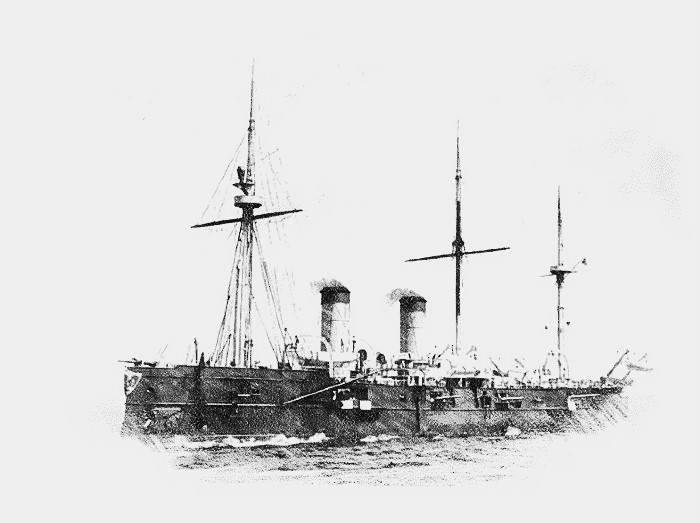
Figure 2. Cruiser "Vladimir Monomah"
In 1896, Rozhestvensky returned to Russia on his ship, handed over command and transferred to the new post of head of the Artillery Training Team. In 1898, he was promoted to the rank of Rear Admiral. In 1900, Admiral Rozhestvensky was promoted to chief of the Artillery Training Detachment, and in 1903 he headed the Main Naval Headquarters, thus becoming one of the most influential people in the naval hierarchy.
Correcting precisely this post, Zinovy Petrovich met the beginning of the war with Japan in January 1904. It is noteworthy that during his more than thirty-year career, he only independently commanded a warship for a little more than two years, and even less - by combining warships in a non-training environment.
Regarding the personal qualities of the admiral, the majority of the people who served with him, noted the extraordinary diligence of ZP Rozhestvensky, conscientiousness in doing things and incredible willpower. At the same time, he was afraid of his abrupt disposition and caustic, at times even rude, expressions that he did not hesitate to use in regard to his subordinates who made mistakes.
For example, what Lieutenant Vyrubov wrote about this in his letter to his father.
Iii. Appointment commander squadron. The organization of the campaign. Shooting and maneuvering training
By the beginning of 1904, in the ruling circles of both Japan and Russia, the opinion was already settled that the war of these two powers was inevitable. The question was only when it starts. The Russian leadership was of the opinion that the enemy would be ready no earlier than 1905 of the year. However, Japan managed to get ahead of these forecasts due to the rigid mobilization of material and human resources and to attack our country at the beginning of 1904.
Russia was not ready for war. In particular, the navy was divided into three connections that were not connected to each other, each of which was inferior in strength to the Joint Fleet of Japan: the First Pacific Squadron in Port Arthur, the Second Squadron, which was being prepared in the Baltic ports, and a squadron of cruisers, based in Vladivostok.
Already at the start of hostilities, the Japanese fleet managed to lock up the First Squadron in the shallow internal raid of Port Arthur and thereby neutralize it.
In this regard, a meeting was held in April 1904, in which, among others, was attended by Emperor Nicholas II, Admiral Avelan, head of the nautical ministry, as well as Admiral Rozhestvensky. The latter expressed the view that it was necessary to prepare the Second Squadron as soon as possible for shipment to the Far East for joint actions with the First Squadron. This view was supported and work on the completion and testing of ships included in the squadron, was given a significant acceleration. In addition, Z.P. Rozhestvensky himself was appointed commander.
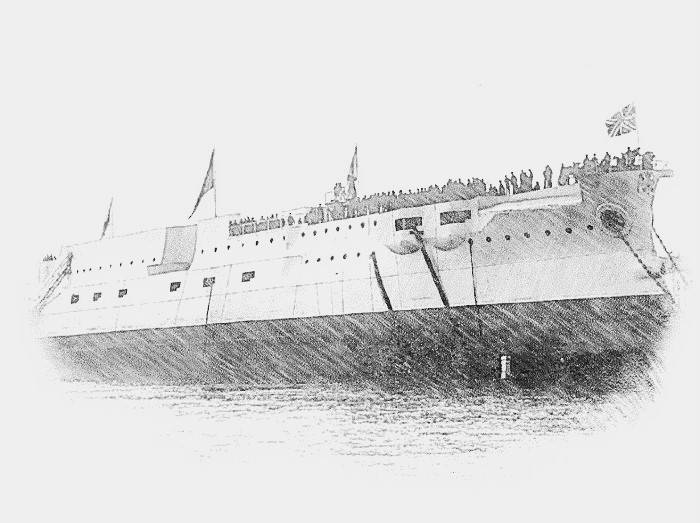
Figure 3. Corps of the EDB "Borodino" after launching
In August of the same year, a second meeting was held. It made a decision about the optimal time for sending the squadron to the campaign: immediately or after the start of 1905 navigation of the year. In favor of the second option, the following arguments were made:
1. Port Arthur most likely will not last anyway until the Second Squadron approaches. Accordingly, she will have to go to Vladivostok, the bay of which may at this time still not be cleared of ice.
2. By the spring of 1905, it would have been possible to complete the construction of the fifth battleship of the Borodino (Glory) series, as well as carry out the entire series of necessary tests on already built ships.
Proponents of the first course of action (among them was Zinovy Petrovich) said that:
1. Even if Port Arthur does not survive, it will be better to join the battle with the United Fleet immediately after the fall of the fortress, until he has time to restore combat capability.
2. Already after the squadron exited from the Baltic, “exotic” cruisers will have time to join it (negotiations on their acquisition were conducted with Chile and Argentina).
3. At the time of the meeting, contracts were already concluded with coal suppliers and a large number of ships were chartered for the same purpose. Their dissolution and re-preparation would have cost the Russian treasury a considerable amount.
ZP Rozhdestvensky particularly focused on the last argument and eventually defended his point of view. Thus, the assembly decided to send the squadron, primarily on the basis of economic considerations, apparently forgetting that the miser pays twice.
It should be noted that the issue of providing their ships with fuel, Admiral Rozhestvensky generally attached decisive importance. Exhausting loading of the cardiff in the most difficult climatic conditions is vividly described in the memoirs of all the participants of the campaign without exception.
Let us pay tribute to the organizational skills of the commander: for the entire period of eight-month voyage, the squadron has never encountered a coal deficit. Moreover, according to the historical commission that studied the actions of the fleet in the Russian-Japanese war, as of the end of April 1905, about three weeks before the Tsushima battle, Zinovy Petrovich had truly enormous reserves: about 14 thousand tons on auxiliary cruisers and transports of the squadron itself, 21 thousand tons on steamboats, going from Shanghai to Saigon (to the location of the squadron), 50 thousand tons on steamboats, chartered in Shanghai. At the same time, on each Borodino-type EDB, about 2 thousand tons were loaded (with a normal supply of about 800 tons), which made it possible to make a transition of at least 3,000 miles or almost 6 thousand kilometers without additional fuel intakes. Remember this value, it will be useful to us in the course of the reasoning, which will be given a little later.
Now we note such a curious fact. From the middle of 19 to the beginning of 20, world shipbuilding made an unprecedented leap forward. Literally every decade, wooden battleships, battery armored frigates, monitors, and casemate battleships alternated between each other. The latter type of ship was replaced by an armadillo with tower-barbet installations, which proved to be so successful that it became widespread in the fleets of all the leading naval powers.
Steam machines, becoming more powerful and more perfect, earned the right to become the only power plants of the ships, sending sailing equipment to the museum shelves. At the same time, ship guns, their sights, target guidance systems and fire control systems were improved. Also steadily increased the protection of ships. From the 10-tee centimeter boards of the era of wooden shipbuilding, a gradual transition was made to the Krupp's 12-inch inch armored tiles, able to withstand direct hits from the most powerful shells of the time.
At the same time, the tactics of naval battles did not keep up with technical progress.
Like a hundred, and two hundred years ago, the decisive action for the capture of the sea was to be a victory in the general battle of the linear fleets, which, lined up in parallel columns, were supposed to subject each other to the most severe shelling. The highest skill of the commander at the same time was considered the ability to put the opponent "stick over Ti", that is, to make the enemy column was on the traverse (perpendicular) of his own column. In this case, all the ships of the commander were able to beat all the artillery of one of the sides of the main vessels of the enemy. The latter, however, could only conduct a weak return fire from tank guns. This method was far from new and was successfully used by such famous naval commanders as Nelson and Ushakov.
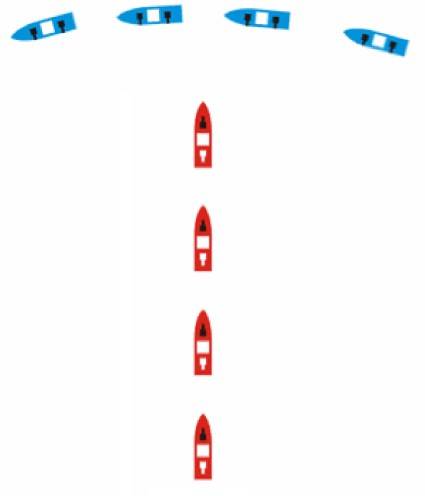
Figure 4. Blue squad puts "wand over Ti" red
Accordingly, with a quantitatively and qualitatively equal ship composition of the two opposing squadrons, the advantage was gained by the one that made evolutions (maneuvered) better and more accurately and whose gunners fired more accurately from the guns.
Thus, Admiral Rozhestvensky, first of all, needed to concentrate on working out the above skills of the compound entrusted to him. What kind of success he was able to achieve during the eight-month voyage?
The first evolutionary teachings Zinovy Petrovich conducted after the arrival of the squadron on the island of Madagascar. The squadron ships that preceded 18 thousands of kilometers from it were done exclusively in the wake column. After the war, the commander explained this by the fact that he could not waste time on training maneuvering, as he tried to move as quickly as possible to Port Arthur.
A certain amount of truth was certainly present in this explanation, but simple calculations show that to travel a path of 10 thousands of miles in length a squadron that had an average speed of the order of 8 nodes would have to spend about 1250 hours or about 52 of a day (without taking into account parking time related to coal loading, forced repairs and waiting for the resolution of the Gulsky incident). If Z.P. Rozhestvensky had dedicated to the teachings on each of these 52 days 2 hours, then arrival to Madagascar would take place only 5 days after the actual, which was hardly critical.
The results of the first training maneuvers are colorfully described in the order of the admiral, released the next day:
"For a whole hour, the 10 ships could not take their seats at the very smallest course of the lead ...".
"In the morning everyone was warned that around noon there would be a signal: suddenly turn everything to 8 points ... Nevertheless, all the commanders were confused and instead of the front they depicted a gathering of foreign ships ..."
Subsequent exercises were a little better. After the next maneuvers Rozhestvensky announced:
“The maneuvering of the squadron of 25 on January 16th was not good. The simplest turns on 2 and 3 rumba, while changing the course of the squadron in the wake of the wake, never succeeded ... ”.
"Turns" suddenly "were especially bad ...".
It is characteristic that the admiral conducted the last training maneuvers already on the day before the Tsushima battle. And they went as far as perfect. The commander even signaled his displeasure to the second and third armored units.
Based on the above, one may get the impression that the commanders of the ships that made up the compound were so hopelessly dull that, despite regular training, they could not learn anything. In reality, there were at least two circumstances, overcoming of which was beyond their competence.
1) The squadron maneuvers were carried out using flag signals, which in turn were decoded using signal books. These operations required a lot of time, which, with frequent changes of signals on the flagship, led to confusion and confusion.
In order to avoid such situations, Admiral Rozhestvensky’s headquarters should have developed a simplified signaling system that would allow them to quickly issue orders to perform certain, previously explained and worked out maneuvers.
However, this was not done, including for the following reason.
2) Admiral Rozhestvensky was a consistent supporter of one-way communication with his subordinates by sending them written orders. He rarely held meetings of junior flagships and ship commanders; he never explained his demands to anyone and did not discuss the results of the exercises.
Therefore, it is not surprising that the connection of the ships, which together passed the order of 30 thousands of kilometers, did not learn to co-ordinate joint maneuvering, which, as we shall see, led to the most serious consequences.
As for the training artillery firing, they were carried out four times. Admiral Rozhdestvensky assessed their results as poorly satisfactory.
"Yesterday's squadron shooting was extremely sluggish ..."
"Valuable 12-inch shells were thrown without any consideration ..."
"Shooting 75-mm guns was also very bad ..."
It would seem logical to assume that the squadron was completely unprepared for battle and needed numerous further training. Unfortunately, they did not follow, and for a rather prosaic reason: the stocks of practical shells, taken by ships from Russia, dried up. Their additional party was expected on the Irtysh transport, which arrived in Madagascar later than the main forces, but they were not there either. As it turned out, the shells, which were so necessary for the squadron, were sent to Vladivostok by rail, which caused the greatest indignation and anger of ZP Rozhestvensky. However, the subsequent detailed study of the correspondence between the squadron commander and the Main Naval Headquarters, which was responsible for picking up the cargo of the Irtysh, did not find any written requirements for sending practical shells to Madagascar.
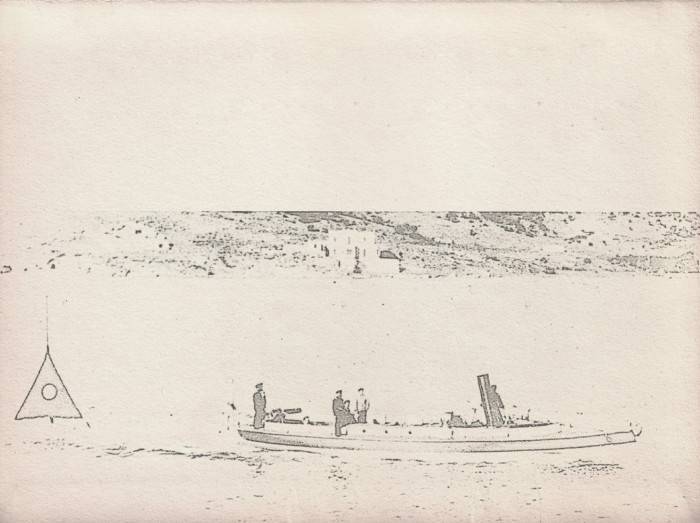
Figure 5. Mine boat tows artillery shield
Admiral Rozhestvensky retained the opportunity to continue training commanders using either small-caliber guns of battleships and cruisers (shells were in abundance), or large-caliber guns mounted on auxiliary cruisers of the compound (reducing ammunition of auxiliary cruisers would not have a significant effect on the combat capability of the squadron whole). However, both of these possibilities were not used.
Iv. Strategy and tactics
When in December 1904, the ships of Admiral Rozhestvensky came to the shores of Madagascar, they were overtaken by two bleak news.
1. The first squadron ceased to exist, without causing any substantial damage to the enemy.
2. Negotiations on the acquisition of cruisers in Latin America ended in complete failure.
Thus, the initial task facing Zinovy Petrovich, namely, the seizure of the sea, was significantly more complicated compared to what it seemed at the August meeting of the highest naval leadership.
Apparently, this consideration so struck the minds of the people who decided on the future fate of the Second Squadron, that they held it for two and a half months in the Nossi-Be bay in Madagascar, despite the persistent requests of the commander to continue moving forward with the aim of interacting with the ships the Japanese fleet before their guns and mechanisms, which had been worn out during the siege, were repaired.
“Having stayed here, we give the enemy time to put the main forces in full order ...”
At the end of January, 1905, these considerations have lost their relevance, but are replaced by new ones.
“Further stay in Madagascar is unthinkable. The squadron eats itself and decomposes physically and morally, ”admiral Rozhestvensky described the situation in his telegram to the 15 February 1905 Manager of the Navy Department.
The Russian ships left Nossi-Be on March 03. Zinoviy Petrovich was ordered to go to Vladivostok, along the way he was strengthened by Rear-Admiral Nebogatov's detachment, on the way from Libau to the Indian Ocean.
Aware of the complexity of the task, Admiral Rozhestvensky frankly telegraphed to the Tsar enough that "The Second Squadron ... the task of mastering the sea is no longer possible."
I believe that if Z.P. Rozhestvensky, for example, S.O. Makarov, were in place, then a resignation letter would be sent with this telegram, which this celebrated admiral would not hesitate to give, not seeing the opportunity to carry out the tasks assigned to him.
However, Zinovy Petrovich abstained from sending such a petition.
The author of the book “Reckoning”, the second rank captain Semenov, explains this contradiction romantically: the admiral did not want anyone to doubt his personal courage, so he continued to lead the squadron towards inevitable death.
However, more reliable is different. By April 1905, the Russian army, which had suffered painful defeats at Liaoyan and Mukden, had been dug in near the city of Jilin and had no forces to launch a counterattack. It was quite obvious that the situation would not change as long as the enemy troops regularly receive material and human replenishment from Japan. Only the fleet was able to break this link between the islands and the mainland. Thus, the squadron of Rozhestvensky became Russia's main and only hope for a successful ending of the war. Nicholas II himself telegraphed to the commander that "All Russia looks at you with faith and strong hope." Rejecting the post, Zinovy Petrovich would have placed both the tsar and the Navy Ministry in such a difficult and ambiguous position that it would undoubtedly ruin any opportunity for him to continue his career. I dare to suggest that the awareness of this particular fact kept the admiral from resigning.
The squadron of Rozhestvensky was connected with the Nebogatov detachment on April 26 of the year 1905. As Novikov-Priboy wrote: “Russia gave us everything it could. The word remains for the 2-th squadron.
Admiral Rozhestvensky, who gathered together all his strength, needed to make a strategic decision on which way to go to Vladivostok. True to himself, Zinovy Petrovich did not become interested in the opinion of either the members of his staff or the junior flagships, and he single-handedly decided to take the shortest route through the Korean Strait. It is clear at the same time realizing that in this case he will definitely meet the main forces of the enemy.
After the war, the squadron commander explained that, in general, he had no choice: the supply of fuel on the ships did not allow them to go round the line along the east coast of Japan without additional coal loading, which would be difficult to do in difficult weather conditions outside equipped bases.
Now back to the size of coal reserves, which we considered somewhat higher. As already mentioned, the battleships of the Borodino type were able to pass with a reinforced coal reserve of at least 6000 kilometers. At the same time, the entire journey from Shanghai to Vladivostok around the Japanese islands would be about 4500 kilometers. Armadillos of other types and first-class cruisers had better seaworthiness and were more adapted to ocean voyages, so this distance was also quite within their power. Also, there was no doubt transports and auxiliary cruisers. Destroyers could easily do this way in tow. The weak link in this logical chain was only the light cruisers “Pearl”, “Emerald”, “Almaz” and “Svetlana”, as well as the battleships of the coastal defense of the Nebogatov detachment. However, taking into account the fact that these ships were clearly not the main striking force of the squadron, they could well have taken the risk.
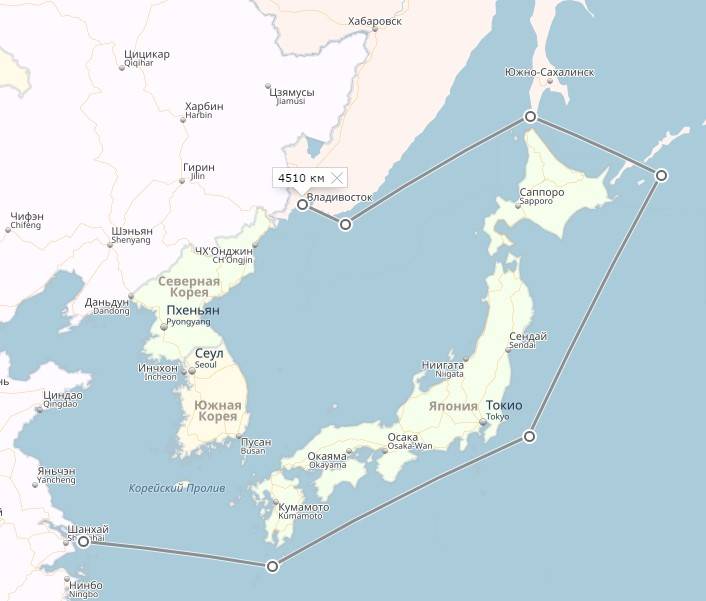
It is likely that if the squadron chose this path for itself, then on the approach to Vladivostok it would be waiting for the ships of Admiral Togo. However, in this case, the Japanese, aware of the distance from their own bases, would probably have been more careful in battle. The proximity of Vladivostok should have given our sailors strength and confidence in the successful completion of navigation. In general, the Russian squadron could have a clear psychological advantage, which, however, did not happen at the behest of its commander.
So, ZP Rozhestvensky decided to take the shortest route through the eastern branch of the Korean Strait. What tactics did the admiral choose to make this breakthrough?
Before answering this question, let us recall the composition of the squadron subordinate to him:
- Borodino squadron battleships, 4 units. ("Eagle", "Suvorov", "Alexander III", "Borodino");
- battleship cruiser "Peresvet", 1 units. ("Oslyabya");
- Ironclad obsolete types, 3 units. (“Sisoy”, “Navarin”, “Nikolay I”);
- armored cruisers of obsolete types, 3 units. ("Nakhimov", "Monomah", "Donskoy");
- Coastal Armadillos, 3 units. ("Apraksin", "Senyavin", "Ushakov");
- Cruiser I rank, 2 units. ("Oleg", "Aurora");
- Cruiser rank II, 4 units. ("Svetlana", "Diamond", "Pearls", "Emerald").
In addition, 9 destroyers, 4 transport, 2 sump steamer and 2 hospital ship.
Total 37 ships.
The first thing that catches your eye is the presence of a squadron of non-combat ships in the squadron that is going to break through.
It is known that the maximum connection speed of several ships cannot exceed the maximum speed of the slowest one, reduced by an 1 node. The slowest transports in the squadron of Rozhestvensky had a maximum turn of the order of 10 nodes, so the whole connection could move no faster than with the 9 nodal speed.
It is clear that in this case, the Japanese troops, moving at a speed of 15-16 nodes, were able to maneuver in relation to our column so as to occupy any position that is most advantageous to them. What made Z.Pozhestvensky take with him into a breakthrough transports, which significantly slowed down the progress of the squadron?
“A considerable difficulty was created by ... a warning to the Main Naval Staff: not to burden the poorly equipped and equipped Vladivostok port and not to rely on a supply by the Siberian road. On the one hand, the elementary rules of tactics prescribed to go into battle lightly and, of course, not to have transports in the squadron, hampering its actions, on the other - this is a kindly warning ... ”
This explanation was offered by the author of the book “Payback”, the captain of the second rank Vladimir Semenov.
The explanation is rather ambiguous, since it is based on the assumption that Russian ships will reach Vladivostok in any case and, acting from there, may experience a shortage of coal and spare parts.
What was the basis of this paradoxical belief that a breakthrough would take place?
Here is the answer to this question, given by Admiral Rozhestvensky himself: “... by analogy with the July 28 battle, 1904 of the year had reason to consider it possible to reach Vladivostok with the loss of several ships ...”.
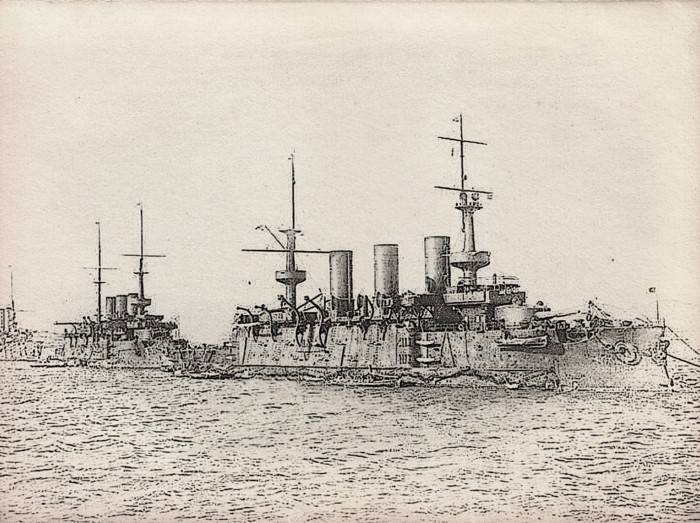
Figure 6. Battleships Peresvet and Victory of the First Pacific Squadron
For a number of reasons, the correctness of the analogy proposed by Zinovy Petrovich is very controversial.
First of all, there were no transports in the convoy of Russian ships that left Port Arthur to Vladivostok that could restrain its progress.
Secondly, the mechanisms of the breaking through ships were not worn out, and the crews were tired of the months-long transition through the three oceans.
Because of this, the squadron of Admiral Vitgeft could develop the course to 14 nodes, which was only slightly less than the speed of the Japanese ships. Therefore, the latter were forced to fight on parallel courses, not occupying a predominant position in relation to the Russian column.
But the main thing is not even all these reservations, but the fact that the outcome of the battle in the Yellow Sea was unfavorable for the Russian squadron. After the failure of the flagship battleship Tsesarevich, it fell into pieces that did not represent a significant combat force: some ships returned separately to Port Arthur, another part disarmed in neutral ports, the cruiser Novik broke through to Sakhalin Island, where it was flooded crew after the battle with the Japanese cruisers "Tsushima" and "Chetse". Nobody reached Vladivostok.
Nevertheless, Admiral Rozhestvensky decided that this experience can, in general, be considered positive, since during the nearly three-hour battle, not a single ship died, and that there are chances of a breakthrough through the location of the main enemy forces.
He organized his squadron as follows.
He divided the twelve armored ships into three groups:
I - "Suvorov", "Alexander III", "Borodino", "Eagle".
II - Oslyabya, Navarin, Sisoi, Nakhimov.
III - “Nikolay I”, “Ushakov”, “Senyavin”, “Apraksin”.
Near the "Suvorov" also located light cruisers "Pearl" and "Emerald", and four destroyers.
On the flagship of each detachment was supposed to be an admiral - the commander of the detachment: Rozhestvensky himself - at "Suvorov", Felkersz - at Oslyab and Nebogatov - at "Nikolai."
Three days before the Tsushima battle, Rear Admiral Felkerszam died. However, for reasons of secrecy, this information was not disclosed and was not communicated even to Rear Admiral Nebogatov. The duties of the junior flagship went to the commander of the battleship Oslyabya, captain of the first rank, Baire.
In principle, this fact did not have any special significance for managing the connection, since Admiral Rozhestvensky did not give his assistants any additional powers, did not allow their troops to take independent actions and did not take into account the opinions of other admirals when making decisions about the route of the squadron and the time it left. Also Zinovy Petrovich did not consider it necessary to discuss with them the plan of the upcoming battle, which he himself considered inevitable.
Instead, two directives were reported that ZP Rozhestvensky apparently considered to be exhaustive:
1. The squadron will follow to Vladivostok in the structure of the wake column.
2. When leaving the flagship, the column should continue to move after the next matelot, until it is reported to whom the command was transferred.
The detachment of cruisers under the command of Rear Admiral Enquist, along with five destroyers, was ordered to keep close to the transports and protect them from enemy cruisers.
In the event of a battle with the main forces of the Japanese, the transports would have to go a distance of about 5 miles and continue on the previously indicated course.
V. Squadron entry into the Korean Strait. Outline and the general course of the Tsushima battlefield
The squadron entered the Korean Strait on the night of 13 on May 14 of 1905. By order of the commander, warships and transports were going out with extinguished lights, but the hospital ships "Eagle" and "Kostroma" carried all the required lights.
Thanks to these lights, the Eagle, and then the entire squadron, were opened by a Japanese auxiliary cruiser, stationed in a guard chain organized by Admiral Togo.
Thus, the chance for covert penetration into the strait (which was favored by darkness and haze over the sea) was not used, which, with luck, could allow Russian ships to avoid battle and reach Vladivostok.
Subsequently, Admiral Rozhestvensky showed that he ordered hospital ships to carry lights, as international rules required. However, in reality such requirements did not exist and there was no need to risk the secrecy of the location.
After sunrise, the Russian ships discovered that they were accompanied by the cruiser Izumi. Zinovy Petrovich graciously allowed him to follow a parallel course (at the same time communicating data on the structure, course and speed of our ships to his flagship), not giving the order to either fire at the battleships or drive off cruisers.
Later, several more cruisers joined the Izumi.
In 12: 05 squadron lay on the course Nord-Ost 23⁰.
In 12: 20, when Japanese scouts disappeared into the misty haze, Admiral Rozhestvensky ordered the 1 and 2 armored units to make a sequential turn to the right on 8 points (90⁰). As he explained during the post-war investigation, the plan was to rebuild all the armored units into a common front.
Leaving aside the question of what the meaning of such a rebuilding was, if it were possible to complete it, and see what happened next.
When the 1 armored unit completed the maneuver, the fog became less frequent and the Japanese cruisers became visible again. Not wanting to show his rebuilds to the enemy, the commander gave a warning signal to the 2 armored squad, and the 1 squad ordered him to make a turn to 8 points again, but now to the left.
It is quite characteristic that no attempts were made to drive away the Japanese cruisers from the squadron to a distance from which they could not observe our rebuilding, and nevertheless complete the evolution that had begun.
The result of these half-maneuvers was that the 1-th armored detachment was on the course parallel to the course of the entire squadron in the distance 10-15 cable.
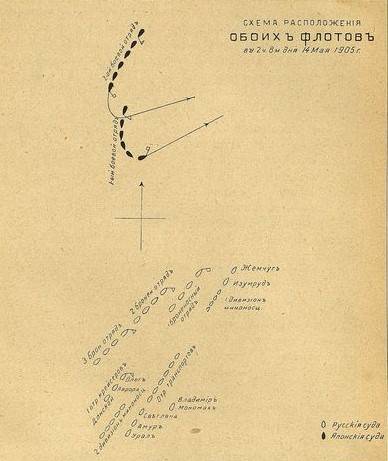
Figure 7. The layout of the fleets before the battle
At 13: 15, the main forces of the United Fleet, consisting of six battleships and six armored cruisers, appeared on a head-on course. Since Admiral Rozhestvensky deliberately did not put any combat guard ahead of the squadron, their appearance was somewhat unexpected for the commander.
Realizing that starting a battle in the ranks of two columns was completely unprofitable, ZP Rozhdestvensky ordered the 1 armored detachment to increase the speed to 11 nodes and take a turn to the left, intending to put him at the head of the common wake column again. At the same time, the 2 armored detachment was ordered to stand in the wake of the 1 armored detachment.
At about the same time, Admiral Togo ordered his ships to make a turn on 16 points in order to take a course parallel to the course of our squadron.
When this maneuver was made, all Japanese 12 ships had to pass through one particular point in 15 minutes. This point was relatively easy to shoot from the Russian ships and, having developed intensive fire, inflict significant damage to the enemy.
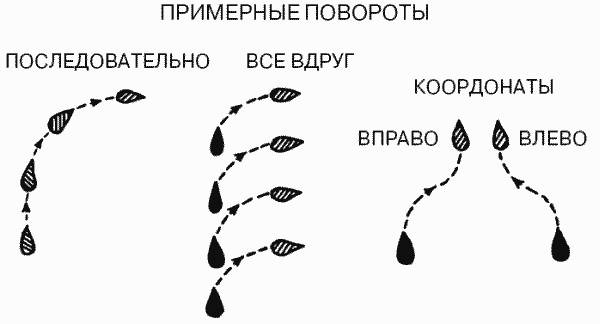
Figure 8. Schemes of turns "sequentially" and "all at once"
However, Admiral Rozhestvensky made a different decision: around 13: 47, a “one” signal went up over the flagship of the squadron, which, in accordance with order No. 29 of 10 in January 1905, meant: “... to concentrate fire as much as possible ... ” In other words, Admiral Rozhestvensky ordered to shoot not at a fixed turning point well viewed from all his battleships, but on the Japanese flagship - the battleship Mikasa, which, having completed the turn, swiftly went ahead, making it difficult to shoot.
Due to the miscalculations made in the implementation of the maneuver of rebuilding two columns into one, the lead ship of the second armored detachment - Oslyabya - began to push the end ship of the first armored detachment - the Eagle. To avoid a collision, "Oslyabya" even turned aside and stopped the cars.
The Japanese were not slow to take advantage of the mistake of the Russian command. The enemy battleships and cruisers, barely past the turning point, opened hurricane fire at the practically stationary Oslyab. During the first twenty-five minutes of the battle, the ship received several large holes in the weakly protected nasal tip and lost more than half of the artillery. After that, the battleship, enveloped in fire, rolled out of order and, after another twenty minutes, sank.
Approximately five minutes earlier, the flagship battleship Suvorov, under the brutal fire of four leading Japanese ships, stopped listening to the rudder and began to describe the circulation to the right. Pipes and masts of it were brought down, many superstructures were destroyed, and the hull represented a giant bonfire from bow to stern.
Figure 9. EDB "Prince Suvorov"
Admiral Rozhestvensky had already received several wounds by this time and could not give orders. However, the ability to control the actions of the squadron, he lost even earlier - as soon as the ship's halyards were burned, they needed to raise the flag signals.
Thus, already forty minutes after the start of the battle, our squadron lost two of the five best battleships, and in fact lost control.
Following the order of the commander, after the failure of the Suvorov for several hours, the formation of the Russian ships was alternately headed by the battleships Emperor Alexander III and Borodino. Twice they attempted, hiding behind the misty fog and smoke of the fires, to rush northward, cutting off the stern to the enemy ships. And both times the opponent successfully stopped these attempts, skillfully maneuvering and using superiority in speed. Over and over again leaving our leading ships abreast of their columns, the Japanese fell upon them with destructive longitudinal (enfilade) fire.
Deprived of the opportunity to conduct effective response fire and having no reasonable plan of action, our squadron at that time, according to the testimony of the Japanese side, was "a few ships huddled together."
Only about seven o'clock in the evening Rear Admiral Nebogatov took command. Raising the “Follow me” signal, he took the surviving ships along the NN-Ost 23⁰ course.
In 19: 30 after hitting a few minutes Whitehead sank the battleship "Suvorov". Admiral Rozhestvensky was no longer on board - previously he and his headquarters were rescued by the “Violent” destroyer and later transferred to the other destroyer, “Poor”.
On the night of 14 on May 15, Russian ships were subjected to numerous mine attacks. It is significant that of the four ships that have been under the command of Admiral Nebogatov (the battleships of the coastal defense and the “Nicholas I”), not one was injured from these attacks. Of the four ships, whose crews were trained by Admiral Rozhestvensky, three were killed ("Sisoy the Great", "Navarin" and "Admiral Nakhimov"). The same fate would certainly have befallen the fourth ship, the Eagle, if during the day's battle it had not lost all the searchlights of combat lighting.
The next day, around 16: 30, the destroyer “Poor” was overtaken by the destroyer “Carp”. Admiral Rozhdestvensky and the ranks of his headquarters were captured by Japanese.
After returning to Russia, Zinovy Petrovich was brought to trial and acquitted by him, despite pleading guilty.
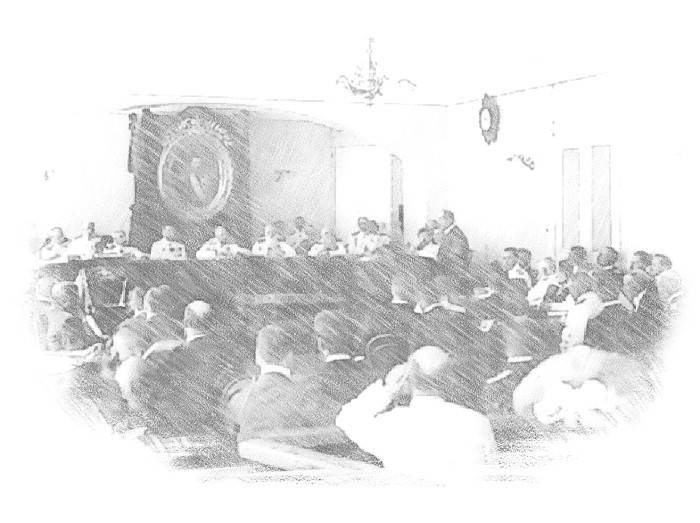
Figure 10. Admiral Rozhestvensky testifies in court
Admiral died in 1909 year. The grave at the Tikhvin cemetery of St. Petersburg has not been preserved.
In conclusion, I would like to quote from the work of the military-historical commission that studied the actions of the fleet during the Russian-Japanese war.
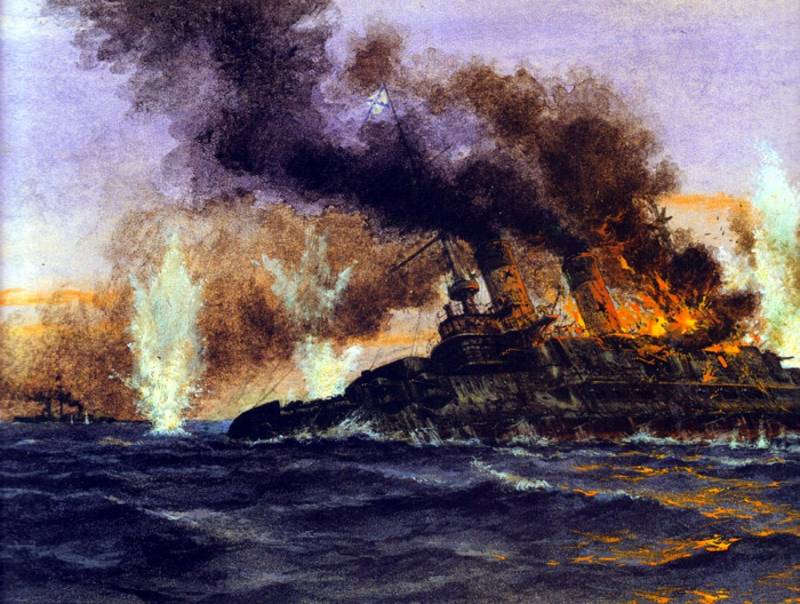
Information